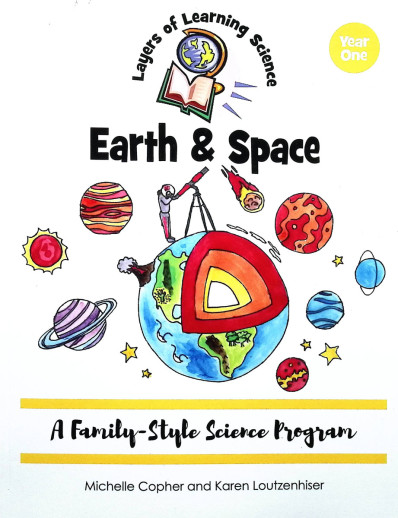We use cookies to make your experience better. To comply with the new e-Privacy directive, we need to ask for your consent to set the cookies. Learn more.
Earth & Space for Layers of Learning (Year One)
Begins with an introduction regarding the tools of a scientist, the scientific method and the history of science. Topics covered include planet earth (old earth/geological timeline), plate tectonics, rocks, fossils, seasons and climate, the weather, as well as the universe and solar system. While an old earth perspective is explored, parents are encouraged to teach from their personal belief system or alternative scientific theories. The Usborne Science Encyclopedia (item #000980 or 018008), the Kingfisher Science Encyclopedia (item 0101980 and the Encyclopedia of Science from DK (OOP) are referenced for all age groups, along with numerous library titles and topics.
The Science Notebook is an essential tool that students need to complete the Layers of Learning Science courses. As students do experiments, make observations, or learn concepts they will record their experiences and learning in the Science Notebook.
At the top of each page there is space for a title. The title is then also written in to the table of contents pages at the front of the book along with the page number. The page or pages are then filled with sketches, data, tables, graphs, calculations, or printables that are pasted in. When the page is finished the young scientist then dates the page and initials it, showing it is his or her work and is complete.
Items listed in this section tend to be complete science programs with a teacher and student component, requiring few supplements besides science supplies.
Options abound for families to learn science together in the elementary years. Firmly believing that families can and should learn together, regardless of age ranges, the authors have created a flexible and organized science program for 1st-12th grade. Each one-year course offers 9 units, with a suggested pacing of one unit per month. Each unit includes an overview, teaching notes, vocabulary lists, conversation starters, library and/or supply lists, and activity or enrichment suggestions. While much of the teaching and some activities are designed to be done together, the units are divided into three grade levels: 1-4, 5-8, and 9-12, for age-appropriate activities. This includes instructions for high school labs that meet traditional high school requirements. Purchase includes a digital, printable package of activity sheets which range from coloring, labeling, journal/log pages, experiment templates, etc. This is different than the optional Science Notebook, which is designed for students to create their own record of learning by adding sketches, tables/graphs, calculations, etc. Evolutionary timeline is utilized. See individual product for lab supply lists and recommended resources.
| Product Format: | Paperback |
|---|---|
| Brand: | Layers of Learning |
| Grades: | 1-12 |
| ISBN: | 9781736062487 |
| Length in Inches: | 11 |
| Width in Inches: | 8.5 |
| Height in Inches: | 0.625 |
| Weight in Pounds: | 1.75 |

